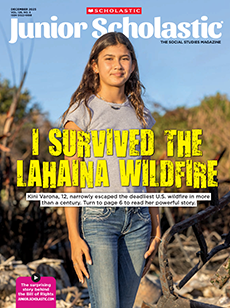Common Core: RH.6-8.1, RH.6-8.2, RH.6-8.4, RI.6-8.7, SL.6-8.1, WHST.6-8.3
KEY STANDARDS
CURRICULUM CONNECTIONS
• Read this article as part of a study of immigration to the U.S. at the beginning of the 20th century.
• Use this piece as part of a discussion on what it means to be an American, and whether the defining characteristics have changed over time.
• Include this article in a lesson about President Donald Trump’s agenda at home and abroad.
Before Reading
1. STUDENT ENGAGEMENT
(10 MINUTES)
Have students work in pairs or small groups to discuss the images depicting immigration then and now. Instruct students to consider the similarities and differences between the photos. Then show our immigration video at junior.scholastic.com.
2. PREVIEW VOCABULARY
(10 MINUTES)
As a class, review the definitions for challenging vocabulary words in the article, including immigration, deportations, refugees, persecution, undocumented, and quotas.
Like What You See?
Then you'll love Junior Scholastic, our social studies magazine for grades 6-8
Read & Analyze
3. INDEPENDENT READING
(20 MINUTES)
Have students read the article on their own, writing down any comments or questions.
4. CLOSE-READING QUESTIONS
(20 MINUTES)
Have students write their answers to each question, or use these prompts to guide a discussion.
- CITING TEXTUAL EVIDENCE: What are some of the arguments in favor of allowing immigrants into the U.S.? What are some of the arguments against it?
(Pro: Immigrants fill jobs Americans don’t want. Immigrants bring new ideas to the U.S. Con: Immigrants take jobs away from American citizens. Some immigrants enter the country illegally and drain the country’s resources.) - CITING TEXTUAL EVIDENCE: In what ways has President Donald Trump moved to reshape immigration policy?
(Trump has stepped up arrests and deportations of undocumented immigrants. He has announced the end of a program protecting young people brought to the U.S. illegally as kids—unless Congress agrees on a plan to save it. His administration has also proposed new measures to limit legal immigration.) - ANALYZING CAUSE AND EFFECT: What was an effect of the Immigration and Nationality Act of 1965, which abolished immigration quotas?
(There was an influx of Asian and Latin American immigrants, for whom the previous quotas had made it difficult to enter the U.S. legally.) - COMPARE AND CONTRAST: The article includes a quote from Benjamin Franklin in which he refers to immigrants as “aliens.” The article later refers to people who have entered the U.S. illegally as “undocumented immigrants.” How do these two terms imply different attitudes toward immigrants?
(Answers will vary but should include the fact that the word alien often has a negative connotation, while the word undocumented is more neutral and pertains more to a person’s legal status.) - DRAWING CONCLUSIONS: Has the definition of what it means to be an American changed over time?
(Answers will vary but may include that the definition has changed over the years as new immigrants have joined the country, bringing their languages, culture, and traditions with them.)
Extend & Assess
5. COMPARE AND CONTRAST
Find out how well students understood the article by having them complete the skills sheet Compare and Contrast: Immigration Then and Now. Go over the answers as a class.
6. WRITING PROMPT
Have students write an essay answering the following questions. Instruct them to use evidence from the article to support their point of view. Why do you think immigration has been the focus of such intense debate over the course of American history? Do you think that will ever change? Why or why not?
7. CONDUCT RESEARCH
Ask students to research an event or time period from the timeline. Then have each student write a short essay explaining what happened, how it affected Americans and immigrants to the U.S., and what effect it had on the country as a whole.
8. ANALYZING A CHART
Have students analyze the “Where They’re From” charts in the article. Ask: In what ways are the two lists similar? How are they different? What, if anything, is surprising? Why might some countries be on one list but not the other?
9. LITERATURE CONNECTION
Pair this article with Emma Lazarus’s poem “The New Colossus,” which appears on the pedestal of the Statue of Liberty. Have students read the poem at libertystatepark.com/emma.htm, then discuss its message about immigration as a class.
DIFFERENTIATING
Lower Level Have students work with a partner to complete the “then and now” skills sheet. Have partners work together to review the questions and look through the article for answers, underlining pertinent passages. Then allow students to work in pairs or independently to complete the skills sheet.
Higher Level Have students use the article to develop interview questions for someone who has been affected by immigration. Interview questions could be geared toward an immigrant, a person whose family members immigrated to the U.S., a local or national politician, or a community member who thinks he or she has been affected by immigration. Offer extra credit to students who conduct and transcribe the interview.

